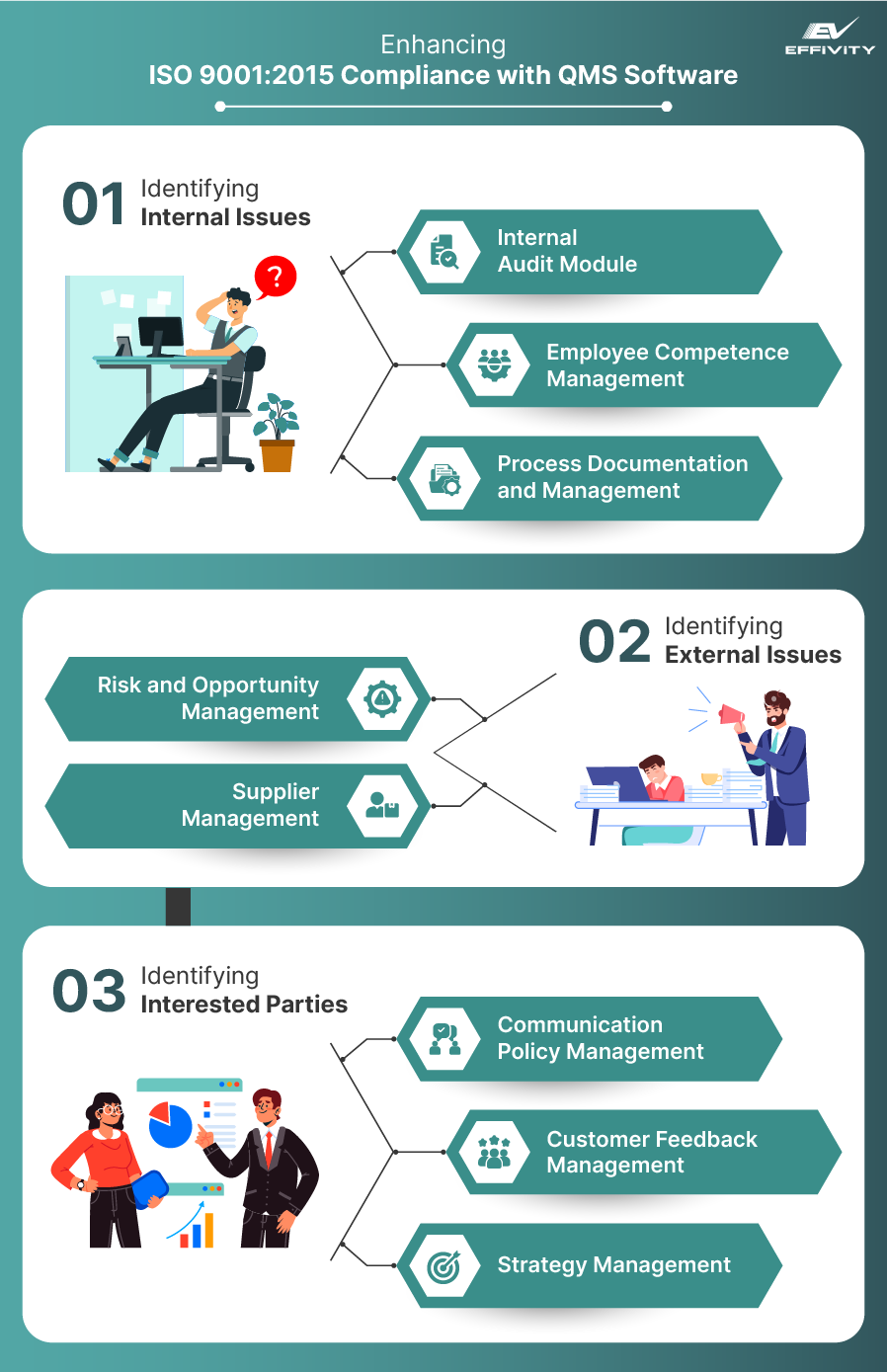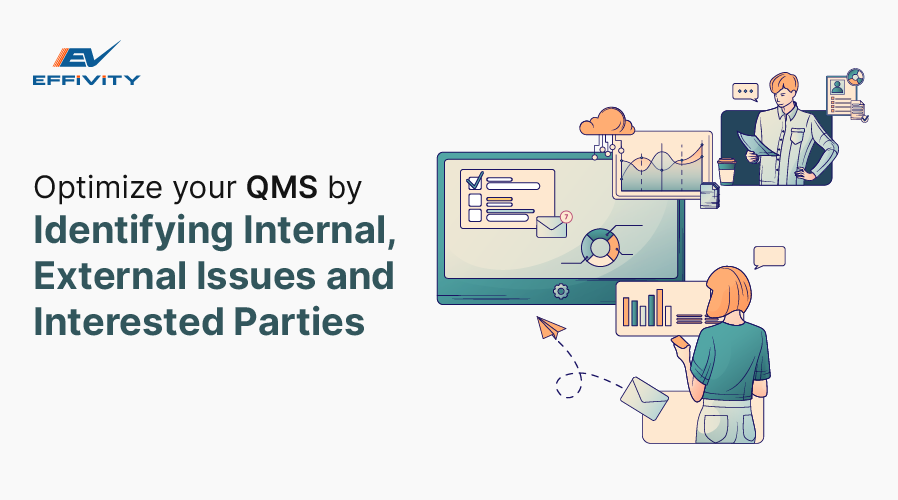ISO 9001:2015 is a framework of standards for managing the quality of business processes. It's used worldwide by companies that wish to consistently meet customer needs and improve their performance. The standards provide a clear guide for documenting processes, responsibilities and expectations to manage and improve quality at all levels.
A key part of this standard is identifying the internal and external factors that influence your quality management system and the people and organizations that have an interest in your success. These groups and factors are important because they influence your capacity to achieve your goals and ultimately decide your success.
You need a clear method to identify internal and external issues and interested parties and address related challenges. This is non-negotiable if you want to maintain high standards and ensure the effectiveness of your quality management system.
In this article, we shall explore the different strategies you can employ to identify these aspects, as well as guide you through using quality management software to achieve the best results.
ISO 9001:2015 Requirements
ISO 9001:2015's Clause 4 focuses on the "context of the organization." This means you need to look closely at your business environment and understand the internal and external issues that can impact your quality management system. The major aspects you need to consider include:

- Internal Issues: These are factors within your company that can affect your ability to meet quality objectives. They include your organizational culture, internal processes and resources. Consider what's happening inside your business, such as changes in staff, new or updated technology, or shifts in your company goals.
- External Issues: These are outside factors that influence your operations and can impact how you manage quality. This might include economic conditions, competitive pressures, regulatory changes and market trends. To identify external factors you need a thorough understanding of the world around your organization and how that world interacts with your business.
- Interested Parties: These are the groups or individuals who have a stake in your business's success. They typically include customers, suppliers, shareholders and regulatory authorities. For ISO 9001:2015, it's important to recognize who these parties are and understand their needs and expectations because they directly affect how well your quality management system performs.
You can tailor your quality management system to be more effective and aligned with both internal needs and external expectations by identifying these elements. This approach helps you manage risks and take advantage of opportunities to improve your business. Here's how you can go about it:
Identifying Internal Issues
Employee Surveys and Feedback: Ask your employees about their experiences and opinions. Their insights can reveal a lot about areas needing improvement or strengths to build upon.
SWOT Analysis: Conduct a SWOT analysis to map out your organization's potential strengths, weaknesses, opportunities and threats. This helps pinpoint internal factors that are helping or hindering your progress.
Management Reviews: Regular reviews by your management team can assess how well your internal processes are working and identify any issues that need addressing.
Identifying External Issues
PESTLE Analysis: Use this method to examine external factors that affect your business. It looks closely at the political, economic, social, technological, legal and environmental elements.
Monitoring Legal and Regulatory Updates: Stay informed about changes in regulations and laws that have an effect on your industry. This ensures compliance and helps anticipate changes that might impact your business.
Engaging with Industry News and Trends: Keep up with industry publications and trends. This can help you predict market shifts and adapt your strategies and processes accordingly.
Identifying Interested Parties
Stakeholder Analysis: Perform a stakeholder analysis to map out everyone who has a stake in your business. Understand their needs and expectations and how they impact your quality management system.
Regular Communication with Key Customers and Suppliers: Maintain open lines of communication with your customers and suppliers. This helps you stay aligned with their expectations and requirements.
Review of Regulatory Requirements and Industry Standards: Regularly review your industry's standards and regulations. This helps you understand what your regulatory stakeholders expect from your business.
Using QMS Software to Identify Internal, External Issues and Interested Parties
QMS software can be a powerful tool to help you identify and manage internal and external issues and keep track of interested parties. A good QMS software should be user-friendly, highly customizable and capable of integrating seamlessly with other tools in your organization. Here's how you can use different modules of a comprehensive QMS software to streamline this process:
Internal and External Issues
- Internal Audit Module: This module allows you to conduct thorough audits of your internal processes. You can easily spot areas that require refinement to ensure your operations align with quality standards.
- Employee Competence Management: Manage and improve your team's skills and performance. This tool helps you identify gaps in employee training and development so that you can consistently maintain high-quality output.
- Process Documentation and Management: Keep all your process documents organized and up-to-date. This module helps you track changes and ensure all processes are efficient and meet regulatory and standard compliance requirements.
- Risk and Opportunity Management: This module helps you identify and manage risks and opportunities from external sources. It provides tools to assess and respond to market changes, regulatory requirements and other external factors.
- Supplier Management: Effectively manage your suppliers to ensure they meet your quality standards. This module helps you track supplier performance and compliance to maintain product and service quality.
Interested Parties
- Communication Policy Management: Streamline communication with all stakeholders, including customers, suppliers and regulators. This module ensures everyone receives timely and relevant information, which is key to managing expectations and building solid relationships.
- Customer Feedback Management: Capture and analyze feedback from your customers to assess their needs and expectations. This module helps you respond effectively to improve customer satisfaction and loyalty.
- Strategy Management: Align your business strategy with the needs of your stakeholders. The strategy management module helps you plan and implement strategies that meet the interests of all parties involved, ensuring your business moves in the right direction.
Final Thoughts
Effectively spotting and handling internal and external issues, as well as knowing what your stakeholders need, helps keep your quality management system strong. Using QMS software with specific modules makes these tasks much easier, offering a clear and structured way to boost compliance, increase efficiency and strengthen relationships with stakeholders.
Integrate QMS software tools into your quality management routine to help your business stay flexible, responsive and ahead of the competition.






























